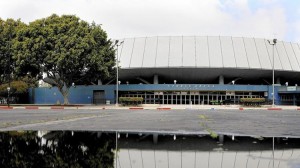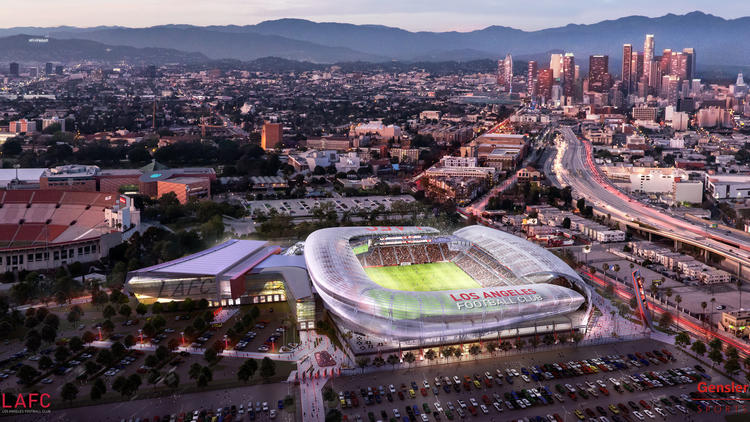The expansion Los Angeles Football Club plans to construct the country's most expensive privately financed soccer stadium on the site of the Sports Ar
The expansion Los Angeles Football Club plans to construct the country’s most expensive privately financed soccer stadium on the site of the Sports Arena in Exposition Park, making it the first open-air professional sports venue to be built in Los Angeles since Dodger Stadium in 1962.
The $250-million complex, covering 15 acres in the shadow of the L.A. Memorial Coliseum, would include a conference center, restaurants and a soccer museum. At its center would be a 22,000-seat stadium, home to the new Major League Soccer franchise when it makes its debut in 2018.
The project, costing $100 million more than the team’s projections seven months ago, still needs approval from the Coliseum Commission and the L.A. City Council. But both groups, along with L.A. Mayor Eric Garcetti, have already expressed support for the project and approval is expected by July.
The decision to go forward with the project was made last week, and the club will formally announce its plans at a news conference Monday.
An addendum to an existing environmental impact report must also be completed, a process that could take up to a year. Demolition of the iconic 56-year-old Sports Arena and construction of the stadium would take an additional two years, delaying the MLS team’s debut by a year.
Construction would be financed by the team and its ownership group, which includes former Lakers Hall of Famer Magic Johnson; Mandalay Entertainment Chief Executive Peter Guber, co-owner of the Dodgers and the NBA’s Golden State Warriors; self-help author Tony Robbins; and women’s World Cup champion Mia Hamm and her husband Nomar Garciaparra, a former major league baseball all-star.
The group estimated the project would create 1,200 temporary construction jobs and 1,800 full-time jobs, generating $2.5 million in annual tax revenue. The project would be eligible for tax incentives.
“This is probably the most exciting thing coming to South L.A. in a long time,” Johnson said. “This is what the community needed. This is what the city of L.A. needed.”
The Sports Arena, which opened in 1959, drew more than 15,000 for its first event, a bantamweight title fight between Mexico’s Jose Becerra and Alphonse Halimi of France.
The low-slung, saucer-like building with a turquoise-lighted facade would go on to host major events over the next five and a half decades, including the 1960 Democratic National Convention. Its first full-time tenants were the USC and UCLA basketball teams, but the Kings, Lakers and Clippers all called it home, as did the ABA’s L.A. Stars and the L.A. Sharks of the World Hockey Assn.
Two NCAA basketball Final Fours, indoor track meets, the 1984 Olympic boxing tournament and concerts by artists such as Madonna, Michael Jackson, Pink Floyd and the Grateful Dead all were held there.
In recent years, the arena had been unable to compete with the larger and more modern Staples Center. Although UCLA played 14 basketball games there in 2011-12 while Pauley Pavilion was being refurbished, the venue was essentially finished when USC’s basketball teams moved across the street to the Galen Center in 2006.
Little opposition is expected from neighborhood groups as the arena is viewed as an eyesore, especially since it fell into disrepair when tenants became scarce. L.A. County Supervisor Mark Ridley-Thomas, in whose district the arena is located, has also publicly supported the project.
Major League Soccer has grown faster than any other U.S. professional league over the last decade, doubling the number of teams to 20 this season. When the Los Angeles Football Club begins play in 2018, the league will have at least 23 teams and it is exploring expansion to Miami, St. Louis or Sacramento.
The league began play in 1996, with many of its teams playing in football stadiums. Now 15 of its 20 franchises play in soccer-specific stadiums —13 of which were built since 2005. Three more are planned.
The StubHub Center in Carson, home to the L.A. Galaxy, opened in 2003 and is the second-oldest soccer-specific stadium in the league.
The LAFC’s 24-member ownership group paid a league-record $110 million expansion fee to join MLS in October, days after the troubled Chivas USA franchise was disbanded. That cleared the way for the LAFC to become Southern California’s second MLS team behind the Galaxy.
New York would be the only other city with two teams in the same area, although its second team plays in New Jersey.

The new soccer stadium was designed by Gensler, a Los Angeles-based architectural firm that recently renovated FirstEnergy Stadium in Cleveland and helped plan Sao Paulo’s Arena Corinthians, which hosted the opening match of last summer’s World Cup.
The L.A. team said at its introductory news conference in October that it would explore stadium sites throughout Southern California, but the Sports Arena location was the only one it seriously considered. MLS has long favored the area because of its proximity to downtown and public transportation.
Although the franchise has always referred to itself as the Los Angeles Football Club, team President Tom Penn said fans will ultimately choose the team’s name.
“It became clear we had to make this decision first,” he said. “Because then every other decision became easier.”
